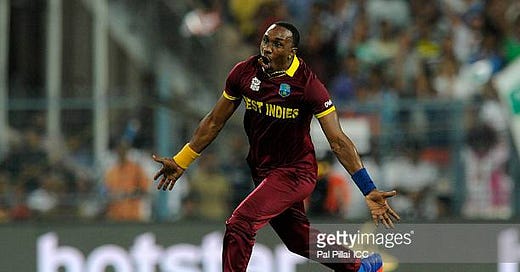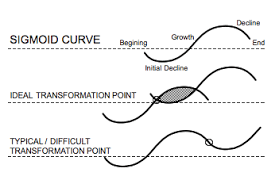The latest episode of DebuTons
Dwayne Bravo has retired from international cricket. It's the end of an era.
I expect his teammates from the golden generation to follow suit. I suspect this was always the plan, one last hurrah on the big stage, a sort of last dance. But things didn’t go according to plan. Everything that wasn’t supposed to happen happened. The team didn’t play well enough, and Sir Andy Roberts and Curtly Ambrose will nod to each other with that knowing look.
They have been on Chris Gayle’s case. They wanted him dropped. They will feel vindicated because Gayle never got going at the World Cup. He only managed 30 runs in 4 innings: 13 vs England, 12 vs South Africa, 4 vs Bangladesh and 1 vs Sri Lanka.
But you have to understand the thinking that had Simmons keeping him in the side. They know what he can do, so the West Indies persisted with him. Unlike the Proteas management, consistency is not a key metric to selection. One big score after five, six or seven low scores gets you dropped from the Proteas side.
In South Africa cricket the management looks for consistency, while other teams or leagues like the IPL look for wow performances. The belief is that out of the 11 players, each player can win two to three games for them out of 14 or so games. So players are more expansive and willing to take risks, they have a license to go play and just play freely.
The West Indies people understand that the failure rate is higher in T20s, so consistency will only be apparent after a long career.
Anyway, Dwayne Bravo, let’s get back to him.
He is one of five players in the current West Indies World Cup squad who belongs to West Indies' golden generation of T20 cricketers. Along with Pollard, Gayle, Russell and Rampaul, Bravo learned his craft at the Stanford 20/20 and the Stanford Super Series, the IPL that came before the IPL.
The Stanford Super Series placed them ahead of the curve. It served as a revolution to cricket in the West Indies. Allen Stanford's project offered big bucks to cricketers, in 2006 Narsingh Deonarine earned an extra $25,000 as a bonus for his slog-sweep over midwicket. It won his team the tournament and was considered the "play of the match". It also provided intense, high octane entertainment to viewers.
Suddenly cricket was a big thing again in the West Indies. It had everyone as excited as the golden years of the West Indies Test side.
Gayle and Pollard went on to play in the Stanford Superstars match against England, where they wiped the floor with the England T20 side, winning the $20 million winner-take-all prize. Bravo was part of the reserves.
T20 cricket has not seen a more dominant group of people or team. While everyone else was approaching T20 like a shorter version of ODI cricket, these guys were playing a different format, a different sport altogether. They hit on the idea of high boundary percentages before everyone else. West Indies players started training for power-hitting before the rest of the world. They caught on to the idea of bowling spinners in the PowerPlay way before anyone thought it clever. They created the blueprint to T20 success. Winning two T20 World Cup titles in the 2010s underlines that fact.
They also pioneered the T20 specialist type of player. If I have my numbers right, they had about 5 or so T20 specialists at the 2016 T20 World Cup. They were the first team to realise the importance of free agents. Something that the Proteas management seems to not fully appreciate, to the detriment of the Proteas team, limiting its success. It seems as if South Africa is stuck in the period West Indies was in 2014. That is a long way behind from 2021.
But, it's happened again. The same way it happened in the 70s, 80s and 90s, where West Indies shaped Test cricket before they fell behind everyone else and disappeared from the format, one can see the pattern emerging. It's like a loop: become so good at something that you redefine how it is done and then get overtaken by everyone else.
They shaped T20 cricket in the noughties and the 2010s, and after years of dominance, they are falling behind.
I say they are falling behind because they went to the World Cup with Pollard, Gayle, Russell, Bravo and Rampaul. The problem is not that these guys are old. Age no longer has as huge an impact on athletes as it did a few years ago. Athletes have hacked that.
I remember reading something from Tim Wigmore that said that ‘since 2000, the average age of the top 100 men’s tennis players has increased from 25 to 28, while in the women’s game, it has increased from 23 to 26. In football, the average age of players rated as among the 250 best in the world has increased from 26.5 to 28 in the past decade.’
Cricket is seeing a similar trend in that regard, especially in T20s, the average age is steadily rising. I don’t have figures, so you will have to take my word on this. It’s been a long time coming.
Martina Navratilova was one of the first elite athletes to hack ageing, that’s how she ended up having a very long career. At 46 she was still winning titles. She was the first tennis player to employ a trainer, nutritionist and head coach. Team Navratilova as it was known. Cristiano Ronaldo has a sleep coach. In fact, sleep has become an integral part of elite athletes’ lifestyles. Besides adding years to careers, sleep has a lot of positive effects on performance.
LeBron James has a strict sleep routine. Serena Williams, Michael Phelps… the list of elite athletes and ex-athletes who invest heavily in sleep is endless. Elite athletes are getting 1% gains from all over the place, from ice baths to strict diets to structured training, things are becoming more individual specific.
Dwayne Bravo has had a personal trainer for years, a strength and conditioning coach whom he works with. His teammates have nutritionists and chefs who create meals and meal plans for them.
Besides hacking ageing, players also hack performance as they grow older. With age comes experience and they simply become better cricketers. Younger players tend to think they can do just about anything and everything. Older players are acutely aware of their limitations, which is one of the many things that time teaches. So, they learn to not only accept their limitations or holes, but it also teaches them to plug those holes. Time makes them more realistic.
I mean, every cricketer has a hole, a weakness, a deficiency. It's a rarity to find a complete cricketer. However, with time and experience, cricketers learn to use their strengths to hide the holes. And they develop little complementary skills that help them to go forward. That's why Faf du Plessis is a better T20 player today, at 37, than he was at 34. Bravo is a better death bowler at 38 than he was at 27 when he stopped playing Tests and ODIs.
These guys are older and wiser. But, the problem of them being at the World Cup is that it shows that none of the younger guys has developed enough to be able to push these players out.

Kieran Powell, Chanderpaul Hemraj, Rahkeem Cornwall and Sherfane Rutherford are nowhere near where these guys are. That batting lineup doesn’t inspire the same awe as one that has Gayle and company. West Indies' T20 success has always been attributed to their batting, and rightly so, it has been lethal. But that's only half the story. The other half is the bowling, Narine, Badree, Rampaul, Bravo, Santokie.
The West Indies attack at this World Cup clearly lacked the sharp pointy bit. It just looked defensive a lot of the time, with no wicket-taking threat. It was blunt, for lack of a better word.
West Indies T20 cricket failed to stay ahead of the curve that they created, partly because no one filled the hole left by Allen Stanford after his arrest, which led to the collapse of the Stanford Super Series. The CPL, which came about 4 years after the Stanford tournaments, is a pale shadow of it.
There is a theory about how to stay ahead of the game. According to Charles Handy, teams go through three stages: the learning phase, the growth phase and, finally, the decline phase.
Handy used the Sigmoid Curve is named after "sigmoid", the Greek word for "s to explain his thinking. According to Handy, the third part, decline, is inevitable many teams, because they get comfortable and fail to plan ahead.
The only way to avoid the decline phase is to make ‘sigmoid leaps’. Develop and promote new talent before the old talent is out of the team. Get them to replace the older stars before they are in their own decline. That way, the failures and hardship that comes with the learning period are masked by the success and ability of other established members of the team. Sometimes teams have to let go of their star performers to make that sigmoid leap.
Instead of being succeeded by a generation of fearsome West Indies T20 cricketers, Bravo, Gayle, Pollard, Russell and Rampaul, and all the other stars that they played with and created this powerhouse with, they are succeeded by other nations. Deja vu.
Thank you to everyone who has shown their appreciation of my work and this newsletter. I am entirely freelance and have no intention of putting content behind a paywall. However, for me to be able to continue producing more content, I depend on your patronage. So, please do support my work on Patreon.
Alternatively, you could Buy A Coffee.
Also, please encourage anyone whom you think may be interested in my work to subscribe.







